Bakso
Bakso or baso is an Indonesian meatball,[2] or a meat paste made from beef surimi.[3] Its texture is similar to the Chinese beef ball, fish ball, or pork ball. The word bakso may refer to a single meatball or the complete dish of meatball soup. Mie bakso refers to bakso served with yellow noodles and rice vermicelli, while bakso kuah refers to bakso soup served without noodles.
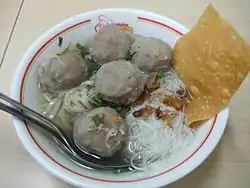 Bakso served with bihun (rice vermicelli) and fried wontons | |
| Course | Main |
|---|---|
| Place of origin | Indonesia, derived from the Chinese meatball |
| Region or state | Nationwide |
| Serving temperature | Hot |
| Main ingredients | Ground beef, tapioca, noodle, rice vermicelli, beef broth, kailan, celery, salted vegetables, fried shallots |
| Variations | Bakwan Malang, phở bò viên (Vietnamese noodle soup with meatballs), Chinese beef balls |
| 1 medium ball of bakso contains 21 mg cholesterol, 134 mg sodium, and 57 calories.[1] kcal | |
Bakso can be found all across Indonesia, from street vendors to high-class restaurants. Along with soto, satay, and siomay, bakso is one of the most popular street foods in Indonesia.[4] Today, various types of ready-to-cook bakso are also available as frozen foods sold in supermarkets in Indonesia. It is usually eaten with noodles.
Ingredients, contents, and serving
.jpg.webp)
Bakso is commonly made from finely ground beef with a small quantity of tapioca flour and salt, however bakso can also be made from other ingredients, such as chicken, pork, fish or shrimp.[4] Unlike other meatball recipes, bakso has a consistent firm, dense, homogeneous texture due to the polymerization of myosin in the beef surimi.
As most Indonesians are Muslims and observe halal dietary laws, bakso usually is made from beef, chicken or a mixture of beef with chicken.[3] In non-Muslim majority areas, such as in the Chinatowns of major cities and on the Hindu majority island of Bali, pork bakso might be found.[5]
Traditionally the beef surimi paste or dough is made into balls by hand and boiled in hot water. After the meat is done, the meatballs are dried and served or refrigerated for later use. Pre-cooked bakso are usually displayed in the windows of street vendor carts.
Bakso are usually served in a bowl of beef broth, with yellow noodles, bihun (rice vermicelli), salted vegetables, tofu, egg (wrapped within bakso), Chinese broccoli, bean sprout, siomay or steamed meat dumpling, and crisp wonton, sprinkled with fried shallots and celery. Slices of bakso are often used and mixed as complements in mie goreng, nasi goreng, or cap cai recipes.
Origin

The name bakso originated from bak-so (肉酥, Pe̍h-ōe-jī: bah-so͘), the Hokkien pronunciation for "fluffy meat" or "minced meat".[6] This suggests that bakso has Indonesian Chinese cuisine origin.[7] Chinese influences is apparent in Indonesian food, such as bakmi, mie ayam, pangsit, mie goreng, kwetiau goreng, bakso, and lumpia.[8] Indeed, bakso texture is quite similar to Chinese beef balls, which is quite fluffy and has homogenous texture. Although bakso has Chinese Hokkien origin name, culinary experts suggests that it is likely that bakso was the mixture of culinary influences back in colonial Dutch East Indies. Also in Indonesian, the term bola daging is often refers to Western or European style of meatballs, which is different in texture and elasticity compared to bakso. For example, Swedish meatballs are translated as bola daging Swedia in Indonesian. The soup and the noodles probably originated in China, but the meatball, may have come from the Dutch, who colonized Indonesia in the 19th century.[3]
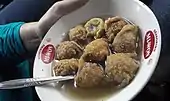
Despite its possible Chinese origin, bakso seems to had undergone localization, especially into Chinese Indonesian and Javanese cuisine. Today, most of the bakso vendors are native Javanese from Wonogiri (a town near Solo) and Malang.[9] Bakso Solo and Bakso Malang are the most popular variant; the name comes from the city it comes from, Solo in Central Java and Malang in East Java. Bakso Solo is usually served with yellow noodle and rice vermicelli in beef broth, while Bakso Malang usually is enrichen with tofu and crispy fried wonton. In Malang, bakso bakar (roasted bakso) is also popular.
In Bandung, West Java, there is a type of bakso called bakso cuanki, which is quite similar with bakso Malang. It can contains various type of bakso ingredients; such as bakso aci, siomay dumpling, boiled wonton, fried wonton, fried bakso, served with scallion and broth soup.[10]
Variations

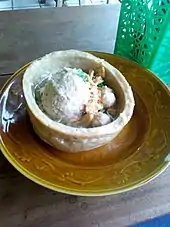
Indonesia has developed numerous bakso variants, usually differing in shape, size, texture, ingredients, and fillings.[11]
- Bakso aci: meatball with more tapioca content
- Bakso ayam: chicken bakso
- Bakso babi: pork meatball
- Bakso bakar: grilled and skewered bakso, prepared in a similar fashion to satay
- Bakso beranak: big meatball filled with small meatballs
- Bakso bola tenis tennis ball-sized bakso, either filled with hard boiled egg as bakso telur or filled with tetelan which includes pieces of spare beef meat and fat or urat (tendon).
- Bakso cuanki: a famous bakso in Bandung, West Java
- Bakso gepeng: flat beef bakso, it usually has finer and more homogenous texture
- Bakso goreng: fried bakso with a rather hard texture, usually consumed solely as a snack or mixed in one bowl as part of bakso Malang or bakso cuanki
- Bakso ikan: fish bakso (fish ball). In Karimunjawa, there is a bakso dish made of caesionidae meat and called bakso ikan ekor kuning.[12] In West Lampung Regency, bakso ikan blue marlin made of marlin, is a common bakso dish.[13] Bakso kakap or snapper bakso dish is scattered in the city of Semarang.[14][15] In Malingping District of Lebak Regency, bakso ikan is made of skipjack tuna or mackerel.[16]
- Bakso jamur, mushroom bakso
- Bakso keju: a modern variant of bakso, filled with either cheddar or mozzarella cheese
- Bakso kotak: cube-shaped bakso
- Bakso krikil: small meatballs like gravels has become a bakso dish in Magelang.[17]
- Bakso lohoa: made from minced chicken meat and prawn mixed with soun noodles, mushroom, and vegetable pieces.[18]
- Bakso Malang: bakso dish from the city of Malang in East Java; complete with noodles, tofu, siomay, and fried wontons
- Bakso mercon: lit. "fire cracker bakso", refer to an extra hot and spicy bakso filled with sambal made of chilli pepper and birds eye chili pepper
- Bakso nyuknyang: bakso dish from Makassar, South Sulawesi. It is eaten with burasa and squeezed of calamansi.[19] The halal version using beef and non-halal one using pork.
- Bakso rusa: venison meatball. A delicacy of Merauke Regency.[20]
- Bakso selimut: egg-wrapped bakso.[21]
- Bakso tahu: bakso meat dough filled into tofu
- Bakso taichan: bakso with sour and super spicy soup.[22]
- Bakso telur: a tennis ball-sized bakso with hard boiled chicken egg wrapped inside
- Bakso tumpeng: cone-shaped bakso
- Bakso udang: shrimp bakso with a slightly pink color
- Bakso urat: bakso filled with tendons and coarse meat
Condiments
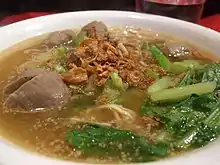
Bakso stalls usually served bottles of sauces, condiments, additions and garnishing. Clients may add these condiments according to their personal preferences. The following condiments and accompaniments are often added upon a bowl of bakso:
- Bawang goreng crisp fried shallot sprinkled upon bakso
- Kecap manis or sweet soy sauce, to add mild sweetness
- Sambal chili paste to add spiciness
- Bottled hot sauce
- Ketchup tomato sauce
- Vinegar to add sourness
- Tongcay preserved salted vegetables
Popularity
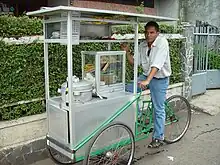
Bakso is one of the most popular street foods in Indonesian cities and villages alike.[4] Travelling street vendors, either by carts or bikes are often frequenting residential areas in Indonesia, while bakso warung and humble tent food stalls are often sprung on street sides in Indonesian cities. Bakso came to international attention when the United States President Barack Obama remembered it as one of his favourite foods from his childhood in Indonesia, and mentioned it in his speech.[2][3] It was also part of a task in The Amazing Race Asia 1, The Amazing Race Australia 1 and The Amazing Race 28 where teams had to either sell and/or eat bakso.
The traveling meatball vendor is often associated with intelligence undercover activity. On social media there are also many memes depicting meatball vendors communicating through walkie-talkies. According to Ridlwan Habib, an intelligence observer, the profession of mobile food traders such as meatball workers is often used by members of the Detective or Densus 88 to spy on terrorist activities or other suspicious criminal activities.[23][24]
Similar dishes
Similar meatball dishes can be found in other Southeast Asian cuisines, such as those in Thailand, Vietnam, Malaysia, and Singapore, as well as Chinese-style meatballs.
The dish also similar with Vietnamese noodle soup with meatballs, phở bò viên.[25][26] In Vietnam, Phở means noodle soup while Bò Viên is meatballs.[27] Phở Bò Viên is one of version of Pho dish in Vietnam. It has been considered as the national dish of Vietnam.[28]
In Malaysia and Singapore, there is a similar meatball soup called bebola daging, which actually a Malay translation of "meatball". Many recipe of bebola daging in Malaysia and Singapore are actually derived from either Western (Indian or European) and Eastern (Chinese) meatballs, such as bebola daging Masala which is derived from Indian cuisine influence.[29]
In the Philippines, meatballs are called almondigas or bola-bola, and are usually served in a misua noodle soup with toasted garlic, squash, and pork cracklings. Bola-bolas are also stewed or pan-fried until golden brown.
Health issue
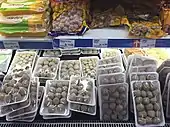
In the past, borax and formalin is often added into beef surimi mixture in order to preserve the produced bakso, also to make bakso more chewy (from borax induced myosin cross-linking) with less usage of meat.[30] As a result, bakso is often listed by Indonesian Food and Drug Administration as an unhealthy foodstuff. The country's Directorate of Consumer Protection warns of the risk of liver cancer caused by high consumption over a period of 5–10 years.[31] The government issued Sodium tripolyphosphate as borax substitute. Today's bakso, frozen bakso being sold at supermarkets and traditional markets in Indonesia are borax free.
References
- "Calories in Indonesian Food Bakso Daging Sapi (Meatball)". My Fitness Pal.
- Rick Rodgers (2011). I Love Meatballs!. Andrews McMeel Publishing. p. 29. ISBN 978-1-4494-1942-4.
- "Bakso: the soup President Barack Obama loved as a child". Nola.com article from The Associated Press.
- Bruce Kraig; Colleen Taylor Sen (2013). Street Food Around the World: An Encyclopedia of Food and Culture. ABC-CLIO. p. 182. ISBN 978-1-59884-955-4.
- "Bakso "100% Haram" dikunjungi ABG sampai Senator". Suluh Bali (in Indonesian). 8 May 2015.
- Herman Ichsan Pangestu (2014). Edward Sitorus (ed.). Sukses Wirausaha Gerobak Terlaris dan Tercepat Balik Modal: 15 Jenis rekomendasi usaha terbaik (in Indonesian). Lembar Langit Indonesia. p. 32. ISBN 978-602-7993-71-6.
- Alison Murray. No Money, No Honey: A study of street traders and prostitutes in Jakarta. Oxford University Press, 1992. p. Glossary page xi.
- Heinz Von Holzen (2014). A New Approach to Indonesian Cooking. Marshall Cavendish International Asia Pte Ltd. p. 15. ISBN 978-981-4634-95-3. Retrieved 16 February 2016.
- Muriel Charras; Marc Pain, eds. (1993). Migrations spontanées en Indonésie. IRD Editions. p. 232. ISBN 978-2-7099-1146-7.
- "Cuanki, Makanan Khas Bandung Dengan Rasa Yang Unik | GreatnessIndonesia.com". Greatness Indonesia. 2018-09-07. Archived from the original on 2020-04-13. Retrieved 2020-04-13.
- Obbie Afri Gultom. "How To Make Bakso: The Indonesian Favorite Food". travelfoodfashion.com.
- Sirojuddin, Ahmad. "Bakso Ikan Ekor Kuning, Bakso Khas Karimunjawa". indonesiakaya.com (in Indonesian). Retrieved 27 April 2023.
- Utami, Adisty Putri. "Gurihnya Bakso Ikan Blue Marlin di Lampung". kumparan.com (in Indonesian). kumparanfood. Retrieved 27 April 2023.
- Adelia, Like. "Kuliner Legendaris Semarang, Kunjungi Bakso Kakap Pak Doel di Kota Lama Semarang". tribunnews.com (in Indonesian). TribunJateng. Retrieved 27 April 2023.
- "Bakso Kakap Pak Wahid". seputarsemarang.com (in Indonesian). Retrieved 27 April 2023.
- Andini, Diong; Rosidi, Achmad. "Wow! Ada Bakso Ikan Khas Malingping Nih". pelitabanten.com (in Indonesian). Retrieved 27 April 2023.
- Agustina, Sinta; Intaniar, Nurul. "4 Tempat Makan Bakso Krikil di Magelang untuk Buka Puasa, Sajian Bakso dengan Kuah Hangat dan Lezat". tribunnews.com. p. Indonesian. Retrieved 27 April 2023.
- Isti, Ayu. "Resep Bakso Lohoa Berbagai Bahan, Cocok untuk Menu Makan Malam". merdeka.com (in Indonesian). Retrieved 27 April 2023.
- Aditomo, Krisna. "Nyuknyang Bakso Khas Makassar". kompas.tv (in Indonesian). Retrieved 26 April 2023.
- Suroto, Hari. "Jangan Kaget Jajan Bakso di Merauke Bukan Daging Sapi, tapi Rusa". detik.com (in Indonesian). detikTravel. Retrieved 28 June 2023.
- Asrianti, Selbi; Rostanti, Qommarria. "Nyobain Uniknya Bakso Selimut Kabut yang Jadi Menu Andalan di Resto MS Bogor". republika.co.id (in Indonesian). Retrieved 13 July 2023.
- Oktaria, Atika. "Nikmatnya Bakso Kuah Taichan". lampost.co (in Indonesian). Retrieved 27 April 2023.
- Sari, Yenny Mustika (2020-12-17). "Gaya 'Intel' Saat Nyamar Jadi Tukang Bakso". detikfood.
- "Kisah Intel Tukang Bakso dan Gado-Gado di Penyergapan Azahari dan Noordin M. Top". kumparan (in Indonesian). Retrieved 2021-02-16.
- "Pho Bo Recipe (Vietnamese Beef Rice Noodle Soup)".
- "Bakso: The 'New' Pho". Archived from the original on 2014-08-21.
- "Bò Viên (Vietnamese Beef Meatballs)".
- "Pho: national dish, international obsession". Vietnews Online. February 14, 2010. Archived from the original on 2010-03-01. Retrieved 2010-07-07.
- "Bebola Daging Ala Masala". Rasa.my. Archived from the original on 2016-03-06. Retrieved 2016-03-02.
- Susiana (3 September 2007). "Boraks Ada dalam Makanan Kita". Suara Merdeka (in Indonesian). Archived from the original on 2008-01-16.
- Staff writer (2006). "Watch Out For The Food We Consume". Directorate of Consumer Protection, Jakarta, Indonesia. Archived from the original on 28 December 2008. Retrieved 2009-02-10.
